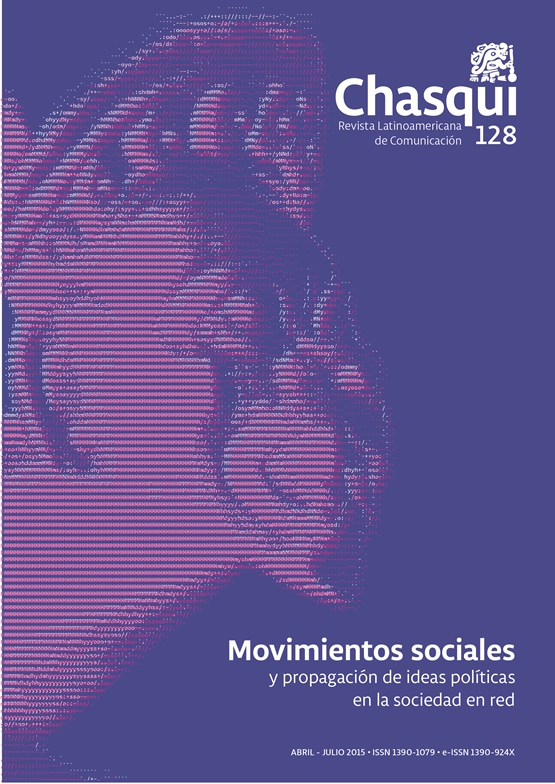The political role of television and internet in contexts of social mobilization: the Chilean case
DOI:
https://doi.org/10.16921/chasqui.v0i128.770Keywords:
social mobilization, democracy, participation, television, internetAbstract
In this paper a reflection on the political role that television and the Internet both have in the current context is offered. For this purpose, this essay took as basis the relationships that social movements established with these media platforms in Chile. The various street demonstrations let us see social unrest and discontent with the representative democracy in Chile, as well as a particular form of “playing politics” that goes along with the different technologies. We try to account for the specific media devices that connect to the emergence of a new political culture. The one which requires thinking how media come not to replace but to establish a new framework of discourse and political action.References
Antezana, L. (2007). Los jóvenes “en” los noticieros televisivos chilenos. Revista Latinoamericana de Ciencias de la Comunicación. Asociación Latinoamericana de Investigadores en Comunicación - ALAIC, 5, 154-163.
Antezana, L. (2010). El noticiero televisivo y su rol social: el caso chileno. Revista Razón y Palabra, 71, 1-12.
Antezana, L. (2012). El “ciudadano” - telespectador en el discurso mediático chileno. Revista Vivat Academia, 118, 76-92.
Blanche, C.; González, T.; Pérez, M.C. & Rivera, C. (2012). Función política de los medios de comunicación en el contexto del movimiento estudiantil chileno 2011. (Seminario de Investigación). Universidad de Chile, Instituto de la Comunicación e Imagen.
Charaudeau, P. (2005). Les médias et l’information. L’impossible transparent du discours. Bruselas: De Boeck Université.
Condeza, R. (2014). La comunicación 2.0 de los adolescentes chilenos movilizados por la educación el 2006 y 2011. Ponencia presentada en el VI Congreso WAPOR Latinoamericano organizado por la Universidad Diego Portales en Santiago. 18 al 21 de junio.
Coulomb-gully, M. (2001). La démocratie mise en scènes. Televisión et élections. Paris: CNRS Editions.
Gubern, R. (1996). Del bisonte a la realidad virtual. La escena y el laberinto. Barcelona: Anagrama.
Kay, R. (2005). Del espacio de acá. Señales para una mirada americana. Santiago: Metales Pesados.
Marion, P. (1996). Le Sport entre récit et médias. Le récit médiatique comme modèle d’interpretation. En Tribunes de presse, etudes sur la construction journalistique du sport (pp. 29-47) Bruselas: Editions Academia-Bruylant.
Neidich, W. (2005). El control de la conciencia global. En Brea, J.L. (Ed.) Estudios visuales. La epistemología de la visualidad en la era de la globalización (pp. 223-242) Madrid: Ediciones Akal.
Sajuria, J. (2013). Is the internet changing our conception of democracy? An analysis of the internet use during protests and its effect on the perception of democracy. Revista Política, 51. 9-29.
Sartori, G. (2009). Homo videns. La sociedad teledirigida. México D.F.: Taurus. Silva, J.P. (2013). Discurso, representación y cultura. La valoración simbólica de los noticiarios de televisión: los movimientos sociales chilenos y la visibilidad social. (Tesis Doctoral). Universidad de Valladolid. Departamento de Prehistoria,
Arqueología, Antropología Social y Ciencias y Técnicas Historiográficas. Soulages, J. (1999). Les mises en scène visuelles de l’information. Etude comparée France, Espagne, Etats-Unis. Paris: NATHAN.
Papathanassopoulos, S.; Coen, S.; Curran, J.; Aalberg, T.; Rowe, D.; Jones, P., Rojas, H. & Tiffen, R. (2013). Online Threat, But Television is Still Dominant. Revista Journalism Practice, 7, 690-704. doi:10.1080/17512786.2012.761324
Winocur, R. (2002). Ciudadanos mediáticos. La construcción de lo público en la radio. Barcelona: Editorial Gedisa S.A.
Downloads
Published
Issue
Section
License
- Authors retain copyright and grant the journal right of first publication with the work simultaneously licensed under a Creative Commons Attribution-NoDerivs License (CC BY-ND) that allows others to share the work with an acknowledgement of the work's authorship and initial publication in this journal.
- Authors are able to enter into separate, additional contractual arrangements for the non-exclusive distribution of the journal's published version of the work (e.g., post it to an institutional repository or publish it in a book), with an acknowledgement of its initial publication in this journal.
- Authors are permitted and encouraged to post their work online.

